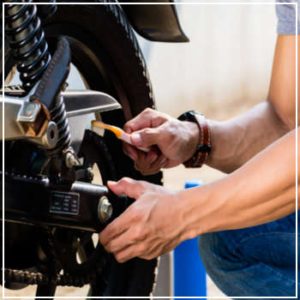For those of us in Connecticut, the early fall means more time to ride. However, as the days get colder and the calendar approaches December, you’ve got to think about winterizing your motorcycle. While you might be tempted to park it in the garage or throw a tarp over it, how you store the bike now directly influences its quality and rideability come springtime. Ultimately, a lack of preparation could mean a rusted, gummy bike with lumpy tires.
So, where should you begin?
When to Store?

Although there’s no set timeline, those in the Northeast often retire their bike toward the end of October or whenever the temperatures turn noticeably cooler. On the other hand, some people extend it until there’s no more sun. Through a combination of these factors, your bike should be prepared and covered before the season’s first snowfall.
Pick a Location
Never leave a motorcycle bike outdoors, exposed to the elements. On a basic level, keep it covered with a secure tarp or in a portable garage. In either instance, the polyethylene material prevents water from building up and rusting the exterior and blocks UV damage. However, make sure the cover doesn’t completely seal off the bike. Otherwise, moisture trapped inside could result in mold, mildew and corrosion. Even inside your garage, a cover prevents dust from accumulating on your bike’s surface.
In an ideal situation, the garage should be a temperature-controlled spot – one that doesn’t get too cold nor too warm. No matter how you monitor the temperature, be wary of condensation and freezing. Condensation invites rust and can damage the tank, while freezing temperatures can result in cracked parts and rodents nesting in your bike.
Make a Maintenance Checklist
So your motorcycle remains in good condition during its time in storage, be sure to have the following done ahead of time:
- Thoroughly wash and dry your bike. Otherwise, bug residue and moisture may corrode the surface.
- Fill up your tank with a combination of gas and stabilizer to prevent the gas tank from rusting and to maintain its consistency. After a month of sitting, gas gets a gummy texture if stabilizer isn’t added.
- For your lubrication system, change the oil and add a new filter.
- For guarding against moisture in your engine, consider having its parts lubricated with oil.
- If your motorcycle has a radiator, be sure to top off the anti-freeze. Otherwise, the moisture inside may turn into ice and end up damaging the piping and engine.
- Set up your motorcycle stand so the tires aren’t leaning against the ground and consider adding a piece of carpet or plywood below, so it’s not sitting directly on concrete. To avoid tire flat spots, remind yourself to rotate them every couple of weeks.
- Think about your battery. Some take it out completely and store it in a dry, room-temperature spot and others hook it up to a trickle charger. Both prevent corrosion and help extend its lifespan. With a trickle charger, make sure it automatically shuts off once a charge is reached. This prevents overcharging and self-discharging in storage.
What’s your procedure for winterizing your motorcycle and when do you start? As we progress through the season, join the conversation on Facebook.
